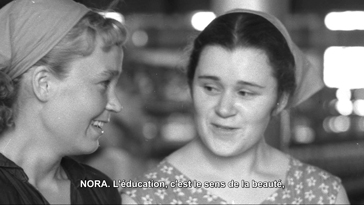
Born in 1976. Lives and works in Talinn (EE) and in Ghent (BE).

2009
Photograph film with sound
Durée : 7'
Year of Purchase: 2012
The camera slowly pans over a sequence of black-and-white photographs. We see modestly dressed women who look at each other, smile, talk. In the background, long rows of power looms stretch across the factory floor. While the images advance on the screen, women’s animated voices can be heard speaking in Estonian. “Eva: Women are hit the hardest, because they have been at it less long. — Nora: It takes away your freedom, so burn it!” The words mirror the images. The text was written in 1977 by the Austrian novelist and playwright Elfriede Jelinek as Scene 15 of her first play entitled, What Happened After Nora Left Her Husband; or Pillars of Society, which is an adaptation of Henrik Ibsen’s Nora (A Doll’s House) (1879) written a century later. The images come from a textile factory archive in Krenholm, Estonia, one of the biggest cotton manufacturers in the communist era.
The film montage, based on the images, is entitled Nora’s Sister. It brings together two sets of materials, neither authored by the artist Marge Monko; each tells a story of the condition of women workers during communism. The choice of Elfriede Jelinek’s feminist and activist text allows Marge Monko to present a complex situation of interaction within a group of women. This is what interests the artist who, after studying art in Austria and Estonia, has worked with the photographic medium and videos, exploring the zones of interaction between psychoanalysis, gender representation, and sociopolitical spaces, such as labor. Monko’s practice bears resemblance to that of artists like Pauline Boudry, Renate Lorenz, and Martha Rosler. However, Monko develops her critical discourse on the limitations of women’s emancipation specifically in the context of communist Europe and its subsequent liberal transition.
Beneath images that express a tender and supportive relationship among women workers, Jelinek’s dialog reveals a tense environment fraught with conflict, where alliances continuously form and dissolve. In fact, opinions diverge and accusations are aimed at Nora, a young woman recently separated from husband, whose claim, “I belong to myself now,” and prediction of upcoming factory closing, rub her fellow workers the wrong way. Intellectual emancipation seems to bring them together, while personal and sexual liberation remains taboo and provokes violent remarks, including the final tirade uttered by the character named Eva, exhausted and lost in her patriarchal conditioning.
Between 2008 and 2009, during the making of the film, the future of the Krenholm factory was uncertain following numerous financial losses and massive layoffs. Two years later, the company went bankrupt. The fate of the Krenholm factory is not an isolated case; it is emblematic of the deindustrialization that progressively swept through Europe in the 1970s. Competition, globalization, outsourcing, and free-market liberalism are among the complex factors contributing to a crisis that has unfolded since the 1970s and escalated in 2008 with the subprime mortgage meltdown. Elfriede Jelinek’s play, written in the 1970s, reflects the early stages of this development. It is interesting to reflect on the topicality of this dialog. What differentiates the rebellions and the dreams of women workers then and now? What would today’s Nora be like? How, if at all, would her thinking have changed? It is up to everyone to raise these questions and, looking at this skillful film montage, wonder about the similarities and differences in the condition of women workers in a time of crisis.
Flora Katz